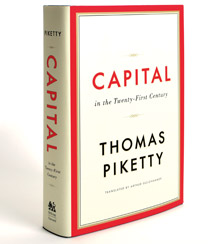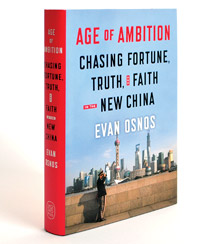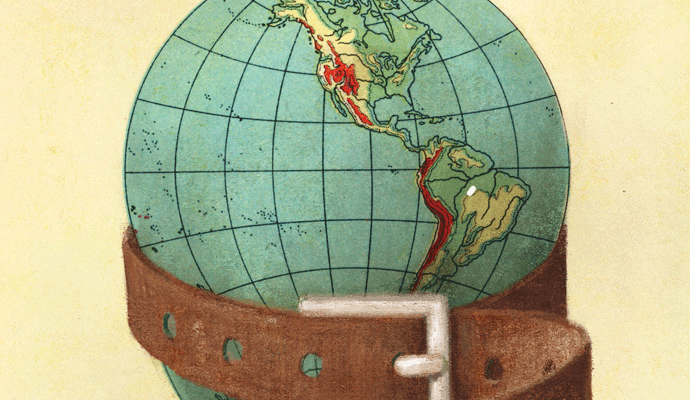Best Business Books 2014: Economics
All Things Being Unequal
Thomas Piketty, translated by Arthur Goldhammer
Capital in the 21st Century
(Belknap Press, 2014)
Evan Osnos
Age of Ambition: Chasing Fortune, Truth, and Faith in the New China
(Farrar, Straus and Giroux, 2014)
Timothy F. Geithner
Stress Test: Reflections on Financial Crises
(Crown, 2014)
The politics, economics, and rhetoric of inequality have been inescapable over the past year. Not since the Gilded Age have we had such vigorous debates over the concentration of wealth and the gap between the rich and the poor. And not just in the United States. In China, where new fortunes are minted daily; in Europe, where social nets are fraying amid economic crises; and in India, where a gleaming technology industry coexists with Dickensian poverty, income inequality is a prominent and often divisive debate.
Among the dozens of books on economics that have crossed my desk in recent months, three in particular have helped illuminate the nature and impact—and resilience—of inequality in our world. One, far and away the best and most important book on economics of the year, is an academic tome on the progression, regression, and rebirth of inequality in Western Europe and the United States. One is a journalistic narrative that takes us deep into modern China, where rampant growth is simultaneously lifting millions from poverty and spawning unprecedented inequality. And one is a memoir of the feverish crisis years in the United States’ financial system, which inadvertently explains how the financial industry was able to reconstitute its fortunes so rapidly after the epic debacle of 2008.
Daniel Gross says the three best books on economics this year illuminate the global nature of income inequality.
Rentiers Redux
Thomas Piketty’s Capital in the 21st Century, the best business book on economics of the year, is also perhaps the most discussed and least read book of 2014. Data collected by Amazon via its Kindle suggested that most readers who bought the bestseller didn’t get much past page 26 of the 577-page (before notes) volume.
On a nine-hour flight, during which I had little else to occupy me than this 42-ounce brick of a book, I managed to get through the whole thing. And it turns out the book everybody was blogging and tweeting about was quite different from the one I read. Capital in the 21st Century is not about the 21st-century U.S. or the hoodie-wearing boy titans of Silicon Valley. It is, in large measure, a book about the vast, powerful forces that have made and broken fortunes in Europe—and then made them again. Because of its focus, which is at once sweeping and limited, I found it to be more interesting and useful as an introductory textbook on the basics of macroeconomics, a primer on 20th-century European and U.S. history, and a brief diversion into the literature of giants like Jane Austen (from which Piketty draws descriptions of how people lived and thought about wages, capital, and investments) than as a prophecy.
Piketty, a French economics professor, illustrates the dynamics of wealth, capital, and growth with a simple equation: R > G. “When the rate of return of capital [R] exceeds the rate of growth of output and income [G], as it did in the nineteenth century and seems quite likely to do again in the twenty-first, capitalism automatically generates arbitrary and unsustainable inequalities that radically undermine the meritocratic values on which democratic societies are based,” he declares.
For much of human history, the global economy barely grew. Between the year 0 and 1700, world output rose at a trifling 0.1 percent compound annual rate. The Industrial Revolution kicked up the growth rate to 1.6 percent, which, says Piketty, is more rapid than many people realize. This growth rate, combined with low inflation and stable prices, was very good news for people who already had money. Inherited wealth snowballed. It was this dynamic that helped construct the grand boulevards and opulent mansions in European cities that we now regard as paragons of equality. Sweden in the 19th century, writes Piketty, “was not the structurally egalitarian country that we sometimes imagine.” In France in 1910, the top 1 percent had 60 percent of the nation’s wealth, and the top 10 percent had 90 percent. Fraternité et liberté, oui. Egalité, non.
Everything changed in the 20th century. As labor organized, wages began to rise. The disintegration of the colonial empires sapped the wealth of Britain and France. World War I, the Bolshevik Revolution, the Great Depression and the accompanying hyperinflation, the rise of Nazism, and the unfathomable destruction of World War II literally destroyed much of the world’s capital. And taxes went up.
“All rich countries, without exception, went into the twentieth century from an equilibrium in which less than a tenth of their national income was consumed by taxes to a new equilibrium in which the figure rose to between a third and a half,” Piketty writes. Although the U.S. suffered less from the destruction of capital, he notes, its progressive taxes were most aggressive. Confiscatory taxation of excessive incomes was a domestic invention: The U.S. was the first country to try tax rates above 70 percent on income—from 1919 to 1922—and various surcharges brought the top rate to as high as 94 percent in 1944.
The biggest force for equality, however, turned out to be inflation. In a series of very sharp insights, Piketty describes how public debt (government deficits) builds private wealth. Government bonds, paid for by the taxes of the broad public, tend to become assets for the rich people who own most of them. The flip side, of course, is that rentiers can be utterly wiped out when inflation rises sharply, which is what happened in Europe in the period from the 1930s to the 1950s. In France, says Piketty, “the enormous deficits of the Liberation were almost immediately canceled out by inflation above 50 percent per year in the four years 1945–1948.” (Germany, where prices rose 300-fold between 1930 and 1950, “was the country that, more than any other, drowned its public debt in inflation in the twentieth century.”) Thanks in part to inflation, between 1914 and 1945, capital in Europe fell from six or seven times national income to a mere two or three times. The high growth of the period between the 1950s and 1980s further helped labor attract a decent and growing share of income in developed countries.
But Piketty finds that those were mere interludes before the inevitable regression to the mean. After 1980, the reconstruction of Europe having been completed, the high-growth era subsided, the world’s central banks killed off inflation, taxes on the rich were cut, and markets soared. Fortunes reconstituted themselves. In France, for example, inheritance flows had dropped from 24 percent of the economy in 1900 to a low of 4 percent in 1950. But by 2000, they stood at 12 percent of the total economy. Rather than dissipating over time—shirtsleeves to shirtsleeves in three generations, as the saying goes—inherited fortunes grew rapidly in the late 20th century. Piketty writes with disdain of Liliane Bettencourt, the heiress to the L’Oréal fortune, “who never worked a day in her life, [but] saw her fortune grow exactly as fast as that of Bill Gates.”
A new wrinkle emerged that helped further tilt the scales toward those at the top. In the 19th century, Piketty explains, people who tried to work their way to riches were chumps. They could never match the gains of capital that already existed. But toward the end of the 20th century, “a stunning new phenomenon emerged… the very top salaries, and especially the pay packages awarded to the top executives of the largest companies and financial firms, reached astonishing heights.” That was in France.
The dynamic of what Piketty calls the “hypermeritocratic society”—a few people getting extremely high salaries—was most pronounced in the United States. Between 1977 and 2007, the richest 1 percent alone vacuumed up 60 percent of the total increase of the country’s national income, pushing inequality levels back to the pre-trust-busting days of 1910. In the U.S., the 1 percent have been running away from the 10 percent, primarily because all-stars—top corporate executives, hedge fund managers, athletes, and top performers in a range of other fields—are raking it in like nobody’s business, in part because they determine their own compensation. Some of those receiving outsized salaries, Piketty notes with irony, are academic economists, who now think the system of “the United States is working fairly well, and, in particular, that it rewards talent and merit accurately and precisely.”
Happiest are those who get paid vast sums from their labor each year, then convert it into capital by investing it. Think of a private equity partner who takes his US$30 million annual payday and plows it into seeding other hedge funds, buying art, and purchasing real estate. Piketty notes, for example, that Bill Gates’s wealth, which is managed by sharp professional investors, has grown just as fast since he stopped working as it did before. “Entrepreneurs thus tend to turn into rentiers, not only with the passing of generations, but even within a single lifetime,” he says.
What can stop these forces from corroding social and political relations? Piketty concludes that a very modest form of confiscation—a global, progressive tax on all forms of wealth—is the only way to rein in inequality while preserving entrepreneurial efforts. But he concedes that “a global tax on capital is a utopian idea.” And so he ends with a certain fatalism about the ever-encroaching power of capital in what is sure to be an age of slow growth. “There is no historical example of a country at the world technological frontier whose growth in per capita output exceeded 1.5 percent over a lengthy period of time,” he writes.
It’s difficult to argue with Piketty’s long-run trends. But I find his reading of history to be too fatalistic, especially as it relates to the short term. If the last 200 years have taught us anything, it is that we should never discount the ability of discontinuities to pop up. Shocks, disruptions, wars, and new technologies have made those who draw straight lines infinitely into the future look like fools with great frequency. For example, there has been no larger economic discontinuity in the past 30 years than China’s emergence as an economic power.
Another quibble with the year’s best business book in this category is that Piketty generally underplays the role of globalization in the rise of capital. Simply put, rich people and the companies they own now have a much broader world to work in. When domestic markets are growing slowly—at 2 or 3 percent—wealthy rentiers have a far greater ability than, say, a small businessperson or a clerk to invest in, participate in, and benefit from the rapid growth in places such as India, Brazil, or, above all, China.
Some Get Rich
The greatest story of our era is China’s so-far successful effort to become less unequal in comparison with other economies in the world. In 1978, the average Chinese income was $200, about one-tenth the world median income. By 2014, it was $6,000, about half the world’s median income. By bringing hundreds of millions of its citizens up from subsistence poverty to a higher standard of living, China is acting as a powerful force against inequality between nations. But the country’s soaring goals, captured lyrically in Evan Osnos’s Age of Ambition: Chasing Fortune, Truth, and Faith in the New China, are also spurring inequality within China.
Whereas Piketty relies on a combination of large data sets and fictional characters to offer an overview of global developments, Osnos, a New Yorker staff writer, takes us inside the lives of ordinary—and extraordinary—Chinese people. Much of the media coverage of China leads casual readers to see the country’s 1.3 billion inhabitants as an undifferentiated mass of commercially minded automatons: pragmatic and disciplined, forgoing leisure for the sake of national development. But Osnos introduces us to idealistic, stubborn individuals who are intent on making their mark in modern China. When Hu Shuli, the tiny, fearless founding editor of muckraking business magazine Caijing, is pushed out of the magazine by the owner, who has tired of her confrontational approach, she starts a new one. Lin Zhengyi defected from Taiwan in 1979, eager to participate in the rebirth of China, and became a well-known economist. In 2008, he was named chief economist of the World Bank—the first professional from any non-developed market to hold that high post. And then there’s Tang Jie, a graduate student in Western philosophy, who made the highly nationalistic viral Internet movie 2008 China Stand Up!
“China reminds me most of America at its own moment of transformation—the period that Mark Twain and Charles Warner named the Gilded Age, when ‘every man has his dream, his pet scheme,’” Osnos writes. And he vividly conveys China’s shady hustling, earnest bustling, and poignant efforts to make up for its lost century—all being led by an authoritarian regime whose mixture of aggression, fear, self-confidence, and inferiority led it to tamp down all types of aspiration not related to making money.
In today’s China, being on the ground floor of any enterprise that gains scale can make you very rich indeed. Jack Ma, a former English teacher who founded e-commerce giant Alibaba, is now one of the wealthiest people in the world, after his firm recently went public. And yet, despite the rampant growth, Osnos finds that opportunity in China is somehow constrained—by corruption, by a shortage of resources, by an overweening state, and by a new Western import: inequality.
“The longer I lived in China, the more it seemed that people had come to see the economic boom as a train with a limited number of seats,” Osnos writes. By 2007, the top 10 percent of urban Chinese were earning 9.2 times as much as the bottom 10 percent. And in 2010, a post charting out how many years it would take a blue-collar worker to earn income sufficient to buy a small apartment in Beijing (about 150) went viral. But public discussion of income inequality is verboten. Among the unintentionally hilarious text messages Osnos receives from the Department of State Council Information Office is this gem: “All websites are requested to remove immediately the article entitled, ‘In China, 94% Unhappy with Wealth Disproportionately Concentrated at the Top.’”
Indeed, Age of Ambition seems to offer a testament to the universality of Piketty’s thesis. Growth in China has been remarkably rapid. But the returns on capital invested in China have risen even faster, creating the same sorts of gaping differentials in economic circumstances that are evident in Europe and the United States. And to a degree, this is by design. “Let some people get rich first,” Deng Xiaoping, the architect of modern China, said.
New Testament Justice
Not even the financial crisis of 2008, which took a healthy bite out of global capital, seemed to affect China significantly. In fact, it didn’t even put much of a crimp in the fortunes of the wealthy in the United States.
Historically, Piketty tells us, financial crises have been great levelers. Certainly, the 2008 crisis should have laid U.S. capital low for a generation, much as the Wall Street crash of 1929 and the ensuing Great Depression did. But thanks in part to a more robust set of institutions (the FDIC, the Federal Reserve) and the aggressive solicitude of politicians of both parties, the system swung into action to save capital from its self-inflicted wounds—a process that is on full display in Stress Test: Reflections on Financial Crises, an engaging, breezy, and perversely fun memoir from former Treasury secretary Tim Geithner.
Geithner is a creature of capital, even though he never actually worked in finance. Well-meaning, personable, profane, and highly competent, he cut his teeth at the Treasury Department during the global financial scandals of the 1990s. As president of the Federal Reserve Bank of New York, he had both a responsibility to ward off trouble and a front-row seat. Throughout, he paints himself as a constant worrier about stability and out-of-control capital.
As the Great Recession started, Geithner was reading Liaquat Ahamed’s Lords of Finance: The Bankers Who Broke the World (Penguin Press, 2009), the magisterial history of the European and U.S. central bankers who botched things horrifically in the 1920s and ’30s. “But I had put it down after a few chapters. It was too scary.” Ever the pragmatist, he rejected the “moral argument about justice, what I called the ‘Old Testament view.’ The venal should be punished. The irresponsible shouldn’t be bailed out.” With regard to capital, Geithner proved to be a distinctly New Testament kind of guy. When a crisis is raging, he says, “the goal should be to protect the innocent, even if some of the arsonists escape their full measure of justice.” This trope appears time and again in Stress Test, as if the two—justice and a functioning system—are mutually exclusive.
In this insider account, full of showdowns with fellow administration members such as Rahm Emanuel and Elizabeth Warren, Geithner argues, correctly, that the bailouts and guarantees largely worked as intended. The TARP money was returned, and a depression was averted. But the innocent weren’t really protected, and the arsonists were rewarded richly. Geithner never adequately explains the dichotomy. The Fed easily invented new powers and instrumentalities to shore up the stock market and financial system, where the rich have their assets. But when it came to bailing out the housing market, which, um, houses the bulk of total wealth for most middle-class people, there was a distinct lack of urgency and effort. Old Testament justice for the homeowners; New Testament justice for their bankers.
Among the dozens of crisis books, Geithner’s stands out partly because it is well written (he was assisted by Time veteran Michael Grunwald). But compared with many of the other protagonists we’ve heard from—especially former Fed chairman Alan Greenspan—he also proves himself to be more pragmatic, self-aware, and self-deprecating. Far from projecting the Olympian calm of Greenspan or former Treasury secretary Hank Paulson, Geithner is forever worrying, nervous, and full of self-doubt. When he was about to assume his role as president of the New York Fed in 2004, he tells us, he got carded at a Manhattan convenience store. Of his first speech as Treasury secretary, he writes, “It was a bad speech, badly delivered, rattling confidence at a bad time.” He provides equally frank descriptions of the bunker behavior of his boss, President Barack Obama, colleagues such as Emanuel and Larry Summers, and frenemies such as former FDIC chair Sheila Bair.
Geithner also tells us that the bailouts succeeded in part because they temporarily transformed huge private obligations into public ones. This financial prestidigitation not only stopped the panic, but paved the way for a recovery favorable to capital. Banks returned to profitability, and the S&P 500 more than doubled, as interest rates and inflation remained low. So the wealthy recovered everything they had lost in the crisis and then some. Meanwhile, median wages and housing prices remain far below their pre-crisis peaks.
According to Geithner, he and his colleagues did their part to reform capital. When lobbyists for financial trade groups came to his office to complain about the Dodd–Frank legislation, he resisted them. “‘My team is beating back your proposals because they’re bad for the country,’ I told them. ‘And we’re going to keep doing it.’”
Geithner also reluctantly supported the Volcker Rule, and small tax increases on higher incomes, which took a bit of wind out of the finance industry’s sails. But only a bit. In our world, the very rich get richer, and they get richer faster than the merely rich. And
it’s not just because of the simple equation of R > G. As Piketty notes, “Wealthy people are constantly coming up with new and ever more sophisticated legal structures to house their fortunes.” What’s more, they’re coming up with new and ever more sophisticated political structures to protect them—friendly government officials of both parties, low tax regimes, and bailouts.
Geithner’s memoir proves instructive here as well. Obama never had the fire in his belly to go after the rich the way that Franklin Delano Roosevelt did. As Geithner describes it, the administration only halfheartedly pursued the so-called Buffett Rule, which would ensure that the very wealthy would pay an effective tax rate of at least 30 percent. At several different points, Obama had opportunities to undo the Bush-era tax cuts, which favored the wealthy. But he never pressed too hard. After eight years of the Obama administration, tax rates on carried interest, estates, high incomes, and capital gains and dividends will all be lower than they were during the Clinton administration.
Capital is doing quite well indeed in the 21st century—thanks to the natural advantages it enjoys, to be sure. But it’s also doing well in part because of the substantial lift it has received from Communists in China and from the United States’ most progressive president in a half century. Très ironique. ![]()
Reprint No. 00293
Author profile:
- Daniel Gross is a columnist for Slate and the Daily Beast. His most recent book is Better, Stronger, Faster: The Myth of American Decline and the Rise of a New Economy (Free Press, 2012).







